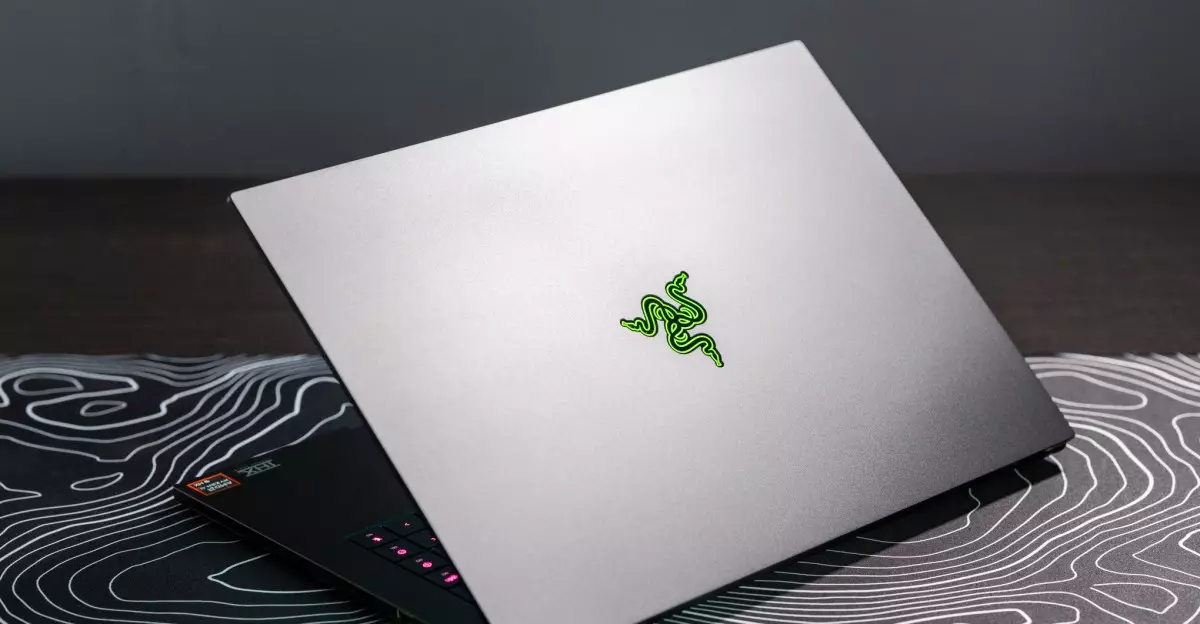The Razer Blade 16 emerges as a standout entry in the competitive landscape of gaming laptops, where aesthetics, performance, and functionality must coexist harmoniously. After years of heavy, bulky machines dominating the scene, Razer’s latest iteration conjures a welcome blend of power and elegance. The Blade 16 manages to retain a sophisticated appearance without sacrificing performance, embodying Razer’s vision for the ultimate gaming laptop. The company has streamlined the design, producing a chassis that is not only thinner—by an impressive 7mm—but also lighter at 0.8 pounds, signifying substantial progress in laptop engineering.
What’s even more compelling is the 16-inch OLED display, boasting a remarkable resolution of 2560 x 1600 and a dazzling refresh rate of 240Hz. This display is not merely a feast for the eyes but a critical aspect for gamers seeking to immerse themselves deeply in a virtual ecosystem. The screen’s crisp and vibrant colors undoubtedly deliver an engaging experience for entertainment and creative endeavors alike—a pivotal factor in distinguishing the Blade 16 from its peers.
Powerful Yet Peculiar Performance
At the heart of the Razer Blade 16 is the new Nvidia RTX 5090 GPU—a leading-edge card that promises a gaming experience that’s both visually stunning and efficiently powered. Razer’s choice to include this GPU aligns well with the current trends in gaming where real-time ray tracing and AI-driven technologies, like DLSS, dominate the landscape. Initial benchmarks suggest that the RTX 5090 may be about 20% more efficient than its predecessors, yet skepticism arises when considering how this efficiency translates into real-world battery performance.
Many users may assume that such a powerful GPU would naturally promote longer battery life during non-gaming tasks. However, the reality deviates from expectations. Reports indicate that the Blade 16 struggles to maintain a reasonable charge while handling basic applications—like Slack or Chrome—casting doubts over its viability as a productivity tool. This poses a significant dilemma for potential buyers willing to spend nearly $4,500: should one invest in a gaming laptop that falters under the weight of standard use?
Keyboard and Build Concerns
The Razer Blade 16’s chic aesthetic is somewhat marred by design choices that provoke frustration, particularly regarding usability. The placement of the new column of macro keys to the right of the keyboard introduces a potential pitfall; users may accidentally mute their microphones or trigger undesired functions instead of executing simple commands. It prompts the question—have gaming laptop manufacturers neglected user ergonomics in their quest for streamlined interfaces? The absence of a more intuitive arrow key arrangement remains a point of contention, revealing an oversight that delivers an otherwise polished experience a slight but noticeable blemish.
Furthermore, during testing phases, hardware-related issues could reflect deeper reliability concerns. While Razer has dedicated resources towards creating an ultra-sleek gaming machine, having to deal with hardware disruptions like blue screens and performance inconsistencies within days of usage raises eyebrows. Even for a high-end laptop, the expectation is for reliability in tandem with performance.
A Balancing Act Between Pleasure and Pragmatism
With an extravagant price tag commanding $4,499.99, the Razer Blade 16 positions itself not merely as a gaming laptop but as a luxury item. The allure of having a versatile machine capable of handling creative software and high-end gaming on-the-go is enticing. However, this dream quickly clouded by factors such as unexpected battery drain and possible thermal management shortcomings. Despite a cooling pad intended to enhance performance, users may find themselves questioning whether trading off portability for power is truly worth it.
The current gaming landscape is highly competitive, with models such as the $2,000 MacBook Pro providing creative professionals decent battery life coupled with industry-standard applications. It raises a fundamental question for buyers: should one settle for a capable dual-purpose device or invest in a premium machine that might underperform in traditional usage scenarios?
When it comes down to it, the Razer Blade 16 embodies a powerful vision for the future of gaming laptops, one that marries sophistication with top-tier performance. Yet, amid its triumphs, shortcomings exist that could easily thwart a user’s experience. As testing continues and reviews unfold, the spotlight remains on whether Razer can iron out the kinks without compromising the enchanting design that has come to define their brand, or if buyers should seek alternatives that offer similar performance sans the hefty price tag.

